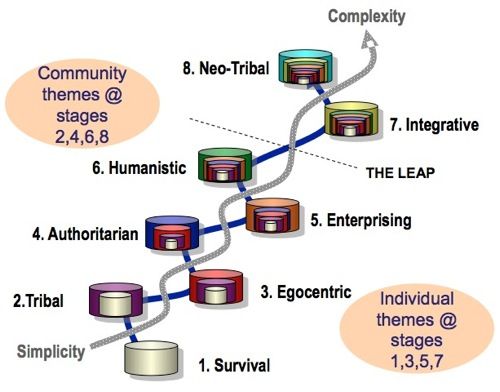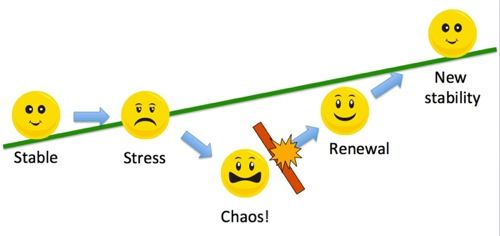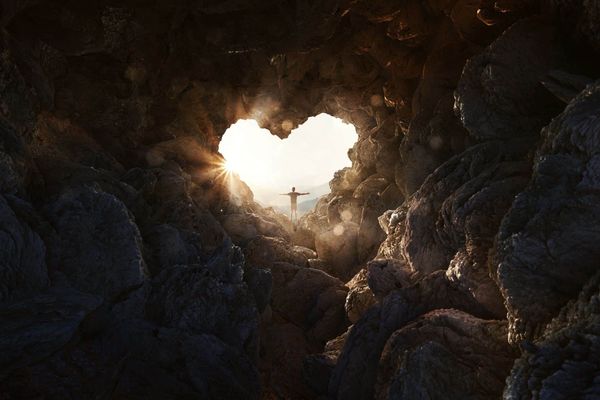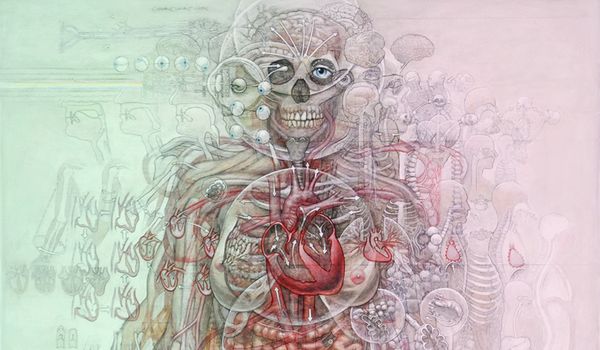Jordan Lejuwaan • • 13 min read
The Impending Change in Global Consciousness: Our Archaic Revival

In 1974, American professor of psychology Dr Clare W Graves wrote an article for The Futurist magazine titled Human Nature Prepares for a Momentous Leap. Graves described an impending change in human consciousness that would be, in his words:
…the most difficult, but at the same time the most exciting transition the human race has faced to date. It is not merely a transition to a new level of existence but the start of a new “movement” in the symphony of human history.
His claim wasn’t just speculation though, it was based on seven years of field research plus almost 20 years of data analysis. Unfortunately he died before publishing his research findings and therefore his work remains largely unknown. Graves’ theory was used as the basis for the book Spiral Dynamics (Beck & Cowan, 1996) and most of his original research papers were eventually published as The Never Ending Quest (Cowan & Todorovic, 2005).
Dr Graves’ findings provide a credible map for what philosopher and psychedelic pioneer Terence McKenna called The Archaic Revival. According to Graves, humanity is indeed making a momentous leap in consciousness, which is characterised in part by the re-emergence of archaic themes. One of these themes is tribalism; not a regression to ancient tribalism, but the emergence of one global tribe.
Graves described human development as ‘an unfolding, emergent, oscillating, spiralling process’ marked by progressive movement upwards through increasingly complex stages. This upward movement is an adaptive response to our changing life conditions. So as our lives become more complex (ie more connected), we are prompted to develop higher, more complex thinking and behaviours in order to cope.
One of the special gifts Dr Graves brought to the field of developmental psychology was his ability at pattern recognition. He discovered that the same change process and the same stages of development can be seen in the evolution of our species, from hunter-gatherer to the present day; in the development of an individual from infant to adult, and also in the development of social groups. Like a fractal, the same pattern shows up at all scales.
Stages of development
The initial data Graves gathered during the 1950s suggested the existence of seven stages of human development. However during the course of his study some of his subjects who displayed Stage 7 behaviour changed to a more complex way of being, an eighth stage, which was entirely unexpected. At the time, no other theory had more than seven stages and it was widely held that Stage 7 was the pinnacle of psychological maturity. Graves eventually concluded that human development is an open-ended process of adaptation, with more stages likely to emerge in the future. A map of the eight stages and their associated themes is shown at Figure 1 (below).

Figure 1. Stages of development
Looking at the map of stages from an individual’s perspective, we begin life at the Survival stage, where as a baby all our energy and attention is consumed simply doing what’s needed to survive. As we grow, we move into the Tribal stage, which explores family and extended family relationships and the associated customs and authority figures. The third, Egocentric stage takes us into an exploration of our personal power and identity, during which (as rebellious teenagers) we attempt to break away from the Tribal dynamics.
Note how each new stage is nested over the top of the previous stages (shown in Figure 1 as nested coloured shapes). Each stage adds a new coping capacity to our repertoire, but as life conditions demand, we can (and do) move down to operate from previous stages when appropriate. One example is our capacity to naturally switch from relatively complex behaviour in the workplace to less complex and more appropriate behaviour in a family situation.
With each new stage a new worldview emerges with its associated interests, motivations and preferences. Transition from one stage to the next represents a major or transformational change, which (for example) can sometimes result in a change of occupation or even life direction.
Progression up through the stages is not a given. It’s dependent upon our life conditions, which include our personal history (our conditioning) and the current challenges we face in life. Only if we’re challenged by new, more complex problems, and if the capacities of our current stage don’t measure up to the task, does the possibility of progress arise through our internal adaptation process.
As a simple example, moving from a quiet rural existence to a busy corporate job in the city brings an increase in complexity. This kind of change can activate our adaptation process, which takes place at a deep internal level beyond the conscious mind. Some people may not adapt though, despite the different life conditions. Graves concluded that we can become temporarily stuck, or even permanently closed off to the change process as a result of certain conditioning.
Many studies have shown that it’s not possible to skip over a stage of development; they must be navigated in sequence. Each new stage builds upon the previous one and as we move from one stage to the next there’s a natural tendency to reject the values of the previous stage, in favour of our new values.
Within the sequence of stages, as indicated in Figure 1 there is an alternating focus between themes of individuality (self-expression) and community (self-sacrifice). The odd numbered stages bring a focus on I/Me/Mine and the even numbered stages a focus on We/Us/Our. This dynamic is like a pendulum that swings back and forth as we move upwards. Ultimately it’s an example of the dynamic balancing of opposites, Yin and Yang, which we find in all natural systems.
Change between stages
The experience of growing from one stage to the next (see Figure 2) takes us from stability at the old stage, through a journey into stress and chaos where the old stage structure falls apart, then on to reorganisation at a new and more complex stage. You’ll notice there are two possible pathways shown, marked as evolutionary and revolutionary change. Revolutionary change involves a breakthrough and a quantum leap, whereas evolutionary change involves a much earlier response and consequently a smaller correction. Change between stages typically follows the revolutionary change path.

Figure 2. The change process
The green line in Figure 2 represents our background life conditions, trending upwards towards greater complexity. When we reach a point of stability and remain there, we eventually fall out of synch with our life conditions by default, due to their constant changing. The stress and chaos result from the gap between what our life conditions are demanding of us and our actual capacity to cope. The larger the gap, the greater the impetus for change. During the chaos phase our old structures fall apart in preparation for reassembly into something new.
Just like the pattern of stage progression, this change pattern is also evident at all scales, from individual to group to the evolution of our species. You’ll notice how it resembles the rising and setting Sun. Many ancient cultures realised this analogy and used the Sun as a spiritual icon to represent the human journey. It can also represent the cycle of death and reincarnation.
This change pattern is the archetypal human experience. It’s what philosopher Joseph Campbell called the Hero’s Journey. The hero leaves his or her home (stability) as the result of some call that disrupts a comfortable lifestyle, commits to the journey and faces tests and trials (stress). At some point there is a major ordeal (chaos) and the hero undergoes a symbolic death and rebirth (crossing the barrier). Our hero emerges from the ordeal with a gift of some sort (renewal) and begins the journey home, where he or she is raised up on high (new stability) in recognition of their achievement.
Altered states and change
‘As a historical cultural phenomenon…anytime a transition in man has taken place there has always been a big upsurge in the use of drugs.’ Dr Clare W Graves, 1971.
The deliberate seeking of altered states of consciousness can be traced back to our earliest recorded history. Most, if not all cultures have some record of using sacred plants, meditation, sound or physical stress as a means to this end. The reasons are many and varied but include for initiation, healing, divination and the expansion of consciousness. Most often the practice was part of a spiritual tradition.
In Integral Psychology (Wilber, 2000) Ken Wilber explains that everyone, regardless of which stage of development they’re operating from, has daily access to the normal states of consciousness; namely the gross (waking), subtle (dreaming) and causal (deep sleep). In an altered state a person may briefly access, while still awake, the subtle and causal realms.
Altered states are often described as psychic or mystical and they can bring feelings or insights that are typical of the higher stages of development, as mapped by Graves. Wilber explains that personal growth to these higher stages involves, in part, the conversion of temporary altered state experiences into permanent realisations.
With regular mindful practice in an appropriate setting, the insights gained through altered states can accelerate our personal development. It’s no wonder that we’re naturally drawn to altered states, particularly during times of change.
Are we living at a special time?
Some sources suggest that 2012 marks a time of significant change. According to the ancient Mayan Calendar it heralds the end of a Long Count of 5,126 years and also the end of the Nine Underworlds cycle, which began with the creation of our universe (Calleman, 2004). In his Timewave Zero theory (T & D McKenna, 1975) Terence McKenna suggests 2012 will be a time of ‘maximized novelty’ (novelty meaning ‘a new or unfamiliar thing or experience’). While these ideas are open to interpretation, interestingly they have some correlations with Dr Graves’ research findings.
According to Graves, the most significant change ever seen in human consciousness occurs during the transition from Stage 6 to Stage 7, and by extension when a critical mass of people reach this transition our world will experience extraordinary change. Graves wasn’t trying to predict the future though, he was simply observing human nature. He once wrote:
‘I didn’t stand on the mountaintop of Sinai and get the word of Jehovah to develop this theory. This point of view came about in a very long series of studies.’
There is a correlation however between the themes of Graves’ human stages and the themes of some of the Mayan underworlds. There is also a similar pattern of time cycles in both the historical appearance of the underworlds and in the appearance of Graves’ stages, with each new underworld and stage being shorter in duration than the previous one.
While none of this provides conclusive evidence of impending change in 2012, by examining the characteristics of Graves’ higher stages we can get some idea of what our momentous leap in consciousness involves and how far off it might be. It’s important to remember that Graves found a few people who’d already transitioned to Stages 7 and 8 way back in the 1950s and he understood the reasons why.
Stage 6 – Preparing For The Leap
Graves noted that Stages 1 to 6 were all focused on supporting oneself in the world and that they all inevitably caused excessive behaviours. The challenges that trigger the emergence of Stage 6 come from the excesses of Stage 5. Namely, materialism and overconsumption, burnout from too much time and effort spent pursuing individual performance goals, a growing social gap between the haves and have-nots, domination of the powerless, short sightedness and too much individualism resulting in a sense of loneliness and a lack of community.
Out of these perceived problems emerges Stage 6 behaviour, which attempts to bring things back into balance. Stage 6 behaviour is community focused and values personal feelings and social connections. It believes everything is relative and that there are many truths, not just one. Decision-making is by consensus, resources are shared and/or recycled and peace and harmony are highly valued.
During Stage 6, as well as focusing on the environment, community and social justice, there is also a strong desire to explore the inner workings of the human being. This leads to a great deal of introspection. We are drawn to revisit all of our previous stages on an internal level and to heal past traumas that are stored within our body and psyche. One of the unfortunate side effects of this process is a greater tendency towards depression and self-harm.
A quick scan of the world in 2011 reveals an upsurge in Stage 6 behaviours, particularly in western countries. This is seen in the popularity of social media, growing community concern for the Earth’s biosphere and resources, growing rejection of our Stage 5 dominated economic systems, and the rise of social movements actively protesting against and in some cases peacefully unseating governments that are operating from earlier stage thinking. This evidence suggests we’re moving rapidly towards a critical mass of people being at Stage 6. How many people constitute a critical mass is difficult to say, but with the aid of social media technology it’s probably less than it used to be.
Stage 7 – The Leap
Graves wrote that the coping capacity or ‘psychological space’ of Stage 7 is greater than the sum of all the previous stages added together. This is a profound change that opens up a multidimensional awareness unlike anything that’s come before. Stage 7 is the first of what Graves called the ‘Being’ levels, where our focus moves from a survival mindset to pondering the question: who am I being in the world?
The challenges that trigger the emergence of Stage 7 come from the excesses of Stage 6 plus the compounding excesses of Stages 3, 4 and 5. Many social problems begin to overlap on each other, multiplying the degree of challenge. These include the depletion of natural resources, overpopulation, climate change and conflict. While Stage 6 has good intentions, most of its attempted solutions are naïve and display an inability to comprehend complex adaptive systems. In some cases they actually make things worse.
Out of these perceived problems emerges Stage 7 behaviour, which is characterised by an absence of fear as a motivating factor, and an absence of compulsiveness. Faced with problems that would overwhelm others, Stage 7 moves beyond an objective, rational approach to a detached cognitive knowing; a trans-rational intuition. With detachment comes the capacity to deal with problems without being swamped by them.
In an echo of the Stage 1 survival themes but at a global level, Stage 7 sees an urgent need for the restoration of our world so that life in all its forms, but especially humanity, can ensure long-term survival. The Stage 7 approach is to consider the systemic whole, working simultaneously across multiple dimensions. It is highly adaptable and for the first time in human history has the conscious ability to swap and change between different behaviour sets. If a problem emerges that requires a typical Stage 5 solution for example, then Stage 7 can adapt to operate like Stage 5.
A quick scan of the world today reveals growing evidence of Stage 7 behaviours, but because of its chameleon-like adaptability, it can be hard to see. Look for people who take a fearless approach, who are very accepting of others yet clear in their own mind as to what must be done; who avoid battling against archaic systems and governments, preferring instead to use minimal effort for maximum effect. To paraphrase Buckminster Fuller, these are the people who’ll build new systems that make the old systems obsolete. When Stage 7 reaches critical mass our world will change radically and quickly.
Stage 8 – The Neo-Tribal Revival
Stage 8 was the most advanced stage that Graves documented, although only six people out of the 1,065 people he studied (0.006%) showed evidence of it.
The primary challenge that triggers the emergence of Stage 8 is how to establish a new way of living that’s in harmony with all human beings, other life forms and our planet’s natural systems. While Stage 7 sought to resolve the various crises that had arisen from the excesses of Stages 1-6, now our thinking turns to long-term stability. We begin to see the Earth as one complex living system with its own intelligence, and ourselves as an integral part of it all.
Stage 8 behaviour is characterised by, in Graves’ own words, ‘an almost mystical’ nature which relies upon feelings and intuition much more than any previous stage. It embraces the mystery of existence and accepts that there are things we can never know; all we can really do is to simply be.
Just as Stage 7 has similarities with Stage 1 survivalism, Graves saw that Stage 8 is a much more sophisticated version of Stage 2 tribalism. Now the tribe is humanity itself and our sacred land is planet Earth. There’s a trend towards a non-interfering minimalistic lifestyle that’s in harmony with nature, while maintaining all the advantages of our high technology. There’s also an acceptance that the human tribe includes a wide variety of people spread across the many stages of development. So sustainable living means acknowledging, nurturing and guiding all these different peoples, their cultures, worldviews and their interaction with the planet and its resources.
Like Stage 7, Stage 8 can be difficult to see in the world due to its minimalistic approach and its chameleon-like adaptability. There is growing evidence though of a neo-tribal revival across the planet, including a growing interest in neo-shamanism and the use of entheogenic plants as allies in our own evolutionary process. Look for people who exhibit the capacities and characteristics of Stage 7, but who are focused on intuitive feeling rather than knowing, who insist on cooperation and trust and who are mindful of long-term sustainability at a planetary level.
Our multilayered unfolding
Based on Dr Graves’ research, the evidence suggests that we are indeed approaching a time of significant and rapid global change. Unlike some New Age predictions however, we’re unlikely to see a sudden leap in consciousness that affects everyone at the same time. Instead, history shows that human evolution is an emergent, oscillating, spiralling, unfolding process that ebbs and flows over time. As an example, the Stage 6 behaviour currently flaring up around the world was first noticed in the mid 1800s with the rise of civil rights movements in the USA. It likely inspired Einstein’s theory of relativity and it played a prominent role in the counter-culture movement of the 1960s. It also powered the thinking behind the World Wide Web and the rise of environmental movements.
Stage 7 has also been around for a while, probably inspiring the birth of quantum science in the early 1900s. However, when a critical mass of people reach Stage 7 its global impact will be greater than any other change in human history. We can expect to see significant changes to our ways of governing, our social systems and our technologies. Again this is a gradual unfolding that’s already underway, but current evidence suggests that we’ll see the cultural equivalent of a record-breaking quantum leap in the not too distant future. Altered state practices, rekindled by the neo-tribal pathfinders of Stage 8, may well play a significant role in accelerating this process. Watch this psychological space!
**This article written by Steve McDonald and was originally published in Entheogenesis Australis (EGA) Journal 3 – 2011/2012 (December 2011)**
Hungry for more? Watch this Bonus Video! (source)
This video below provides a beautiful example of the change process, including the change dynamic which takes us between stability and chaos, and the progression through stages of increasing complexity.
In the video, rock salt has been sprinkled on a metal plate. Sound waves are then passed through the plate causing it to vibrate. Watch as the sound starts at a low frequency and slowly increases. At various times ‘standing waves’ of sound generate a pattern in the salt. As the sound frequency continues to rise, each pattern breaks down into chaos and then reforms into a new pattern, with the new patterns becoming more complex as the frequency/vibration increases. This is the same pattern that occurs in our consciousness as we change.










